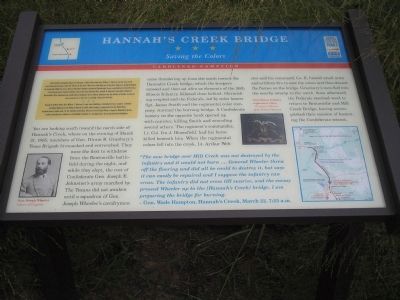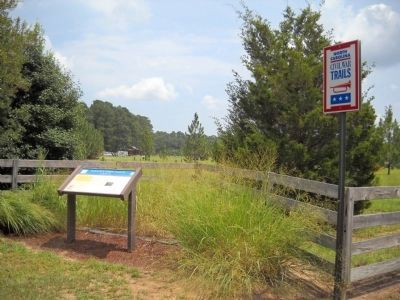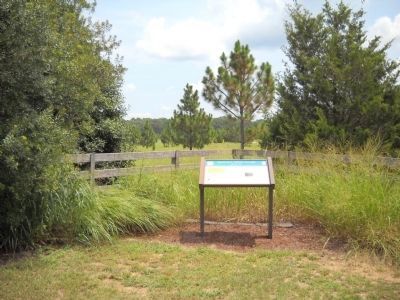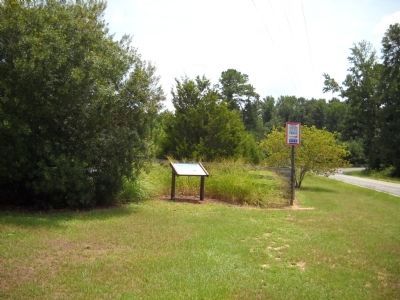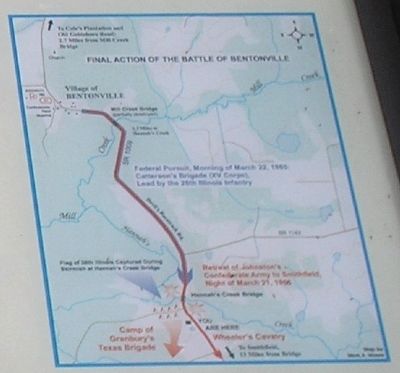Near Four Oaks in Johnston County, North Carolina — The American South (South Atlantic)
Hannah’s Creek Bridge
Saving the Colors
— Carolinas Campaign —
(Preface): The Carolinas Campaign began on February 1, 1865, when Union Gen. William T. Sherman led his army north from Savannah, Georgia, after the “March to the Sea.” Sherman's objective was to join Gen. Ulysses S. Grant in Virginia to crush Gen. Robert E. Lee's Army of Northern Virginia. Scattered Confederate forces consolidated in North Carolina, the Confederacy's logistical lifeline, where Sherman defeated Gen. Joseph E. Johnston's last-ditch attack at Bentonville. After Sherman was reinforced at Goldsboro late in March, Johnston saw the futility of further resistance and surrendered on April 26, essentially ending the Civil War.
You are looking toward the north side of Hannah’s Creek, where on the evening of March 21, 1865, members of Gen. Hiram B. Granbury’s Texas Brigade bivouacked and entrenched. They were the first to withdraw from the Bentonville battlefield during the night, and while they slept, the rest of Confederate Gen. Joseph E. Johnston’s army marched by. The Texans did not awaken until a squadron of Gen. Joseph Wheeler’s cavalrymen came thundering up from the south toward the Hannah’s Creek bridge, which the troopers crossed and then set afire as elements of the 26th Illinois Infantry followed close behind. Skirmishing erupted and the Federals, led by color bearer Sgt. James Smith and the regimental color company, stormed the burning bridge. A Confederate battery on the opposite bank opened up with canister, killing Smith and wounding several others. The regiment’s commander, Lt. Col. Ira J. Bloomfield, had his horse killed beneath him. When the regimental colors fell into the creek, Lt. Arthur Webster and his command, Co. E, braved small arms and artillery fire to save the colors and then doused the flames on the bridge. Granbury’s men fled into the nearby swamp to the north. Soon afterward, the Federals received word to return to Bentonville and Mill Creek Bridge, having accomplished their mission of hastening the Confederate retreat.
“The new bridge over Mill Creek was not destroyed by the infantry and it would not burn …. General Wheeler threw off the flooring and did all he could to destroy it, but says it can easily be repaired and I suppose the infantry can cross. The infantry did not cross till sunrise, and the enemy pressed Wheeler up to the [Hannah’s Creek] bridge. I am preparing the bridge for burning.” - Gen. Wade Hampton, Hannah’s Creek, March 22, 7:25 a.m.
Erected by North Carolina Civil War Trails.
Topics and series. This historical marker is listed in this topic list: War, US Civil. In addition, it is included in the North Carolina Civil War Trails series list. A significant historical date for this entry is March 21, 1865.
Location. 35° 22.212′ N, 78° 18.488′ W. Marker is near Four Oaks, North Carolina, in Johnston County. Marker is on Devils Racetrack Road, on the right when traveling north. Marker is located near the Rudolph Howell and Son Environmental Learning Center. Touch for map. Marker is at or near this postal address: 6607 Devils Racetrack Rd, Four Oaks NC 27524, United States of America. Touch for directions.
Other nearby markers. At least 8 other markers are within 2 miles of this marker, measured as the crow flies. Mill Creek (approx. 1.4 miles away); Confederate Works (approx. 1½ miles away); Bentonville (approx. 1.6 miles away); Village of Bentonville (approx. 1.6 miles away); Johnston Establishes His Headquarters (approx. 1.8 miles away); a different marker also named Village of Bentonville (approx. 1.8 miles away); Mower’s Charge Reaches Johnston’s Headquarters (approx. 1.8 miles away); Johnston’s Headquarters (approx. 1.8 miles away). Touch for a list and map of all markers in Four Oaks.
